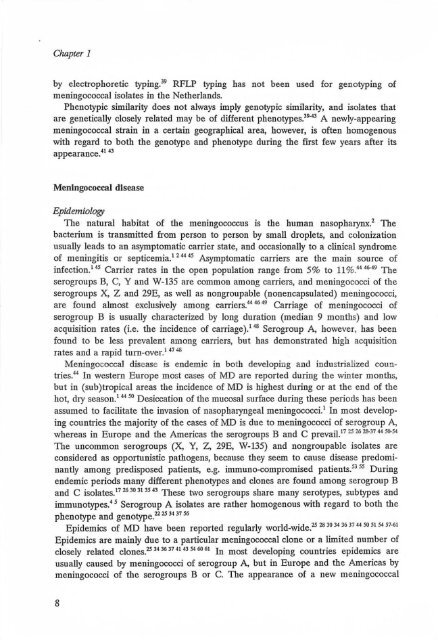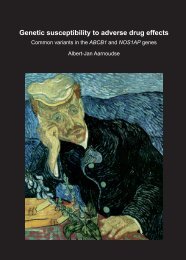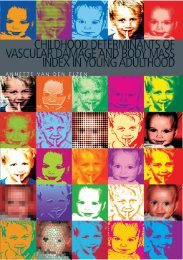An attempt at an epidemiological explanation - Epib.nl
An attempt at an epidemiological explanation - Epib.nl
An attempt at an epidemiological explanation - Epib.nl
- No tags were found...
Create successful ePaper yourself
Turn your PDF publications into a flip-book with our unique Google optimized e-Paper software.
Chapter 1by electrophoretic typing." RFLP typing has not been used for genotyping ofmeningococcal isol<strong>at</strong>es in the Netherl<strong>an</strong>ds.Phenotypic similarity does not always imply genotypic similarity, <strong>an</strong>d isol<strong>at</strong>es th<strong>at</strong>are genetically closely rel<strong>at</strong>ed may be of different phenotypes .' ~4l A newly-appearingmeningococcal strain in a certain geographical area, however, is often homogenouswith regard to both the genotype <strong>an</strong>d phenotype during the first few years after itsappear<strong>an</strong>ce.41 43Meningococcal diseaseEpidemiologyThe n<strong>at</strong>ural habit<strong>at</strong> of the meningococcus is the hum<strong>an</strong> nasopharynx.' Thebacterium is tr<strong>an</strong>smitted from person to person hy small droplets, <strong>an</strong>d coloniz<strong>at</strong>ionusually leads to <strong>an</strong> asymptom<strong>at</strong>ic carrier st<strong>at</strong>e, <strong>an</strong>d occasionally to a clinical syndromeof meningitis or septicemia. l 24445 Asymptom<strong>at</strong>ic carriers are the main source ofinfection,14S Carrier r<strong>at</strong>es in the open popul<strong>at</strong>ion r<strong>an</strong>ge from 5% to 11%.4446-49 Theserogroups B, C, Y <strong>an</strong>d W-135 are common among carriers, <strong>an</strong>d meningococci of theserogroups X. Z <strong>an</strong>d 29E, as well as nongroupable (nonencapsul<strong>at</strong>ed) meningococci,are found almost exclusively among carriers.44 46 49 Carriage of meningococci ofserogroup B is usually characterized by long dur<strong>at</strong>ion (medi<strong>an</strong> 9 months) <strong>an</strong>d lowacquisition r<strong>at</strong>es (i.e. the incidence of carriage).'" Serogroup A, however, has beenfound to be less prevalent among carriers, but has demonstr<strong>at</strong>ed high acquisitionr<strong>at</strong>es <strong>an</strong>d a rapid turn_over. 14748Meningococcal disease is endemic in both developing <strong>an</strong>d industrialized couotries.«In western Europe most cases of MD are reported during the winter months,but in (sub)tropical areas the incidence of MD is highest during or <strong>at</strong> the end of thehot, dry season.' .. 50 Desicc<strong>at</strong>ion of the mucosal surface during these periods has beenassumed to facilit<strong>at</strong>e the invasion of nasopharyngeal meningococci l In most developingcountries the majority of the cases of MD is due to meningococci of serogroup A,whereas in Europe <strong>an</strong>d the Americas the serogroups B<strong>an</strong>d C prevail. 17 2.526 28-3144.56-S4The uncommon serogroups (X, Y, Z, 29E, W-135) <strong>an</strong>d nongroupahle isol<strong>at</strong>es areconsidered as opportunistic p<strong>at</strong>hogens, because they seem to cause disease predomin<strong>an</strong>tlyamong predisposed p<strong>at</strong>ients, e.g. in2muno-compromised p<strong>at</strong>ients." ss Duringendemic periods m<strong>an</strong>y different phenotypes <strong>an</strong>d clones are found among serogroup B<strong>an</strong>d C isol<strong>at</strong>es,l7 26 30 313543 These two serogroups share m<strong>an</strong>y serotypes, subtypes <strong>an</strong>dimmunotypes." Serogroup A isol<strong>at</strong>es are r<strong>at</strong>her homogenous with regard to both thephenotype <strong>an</strong>d genotype.'''''''7''Epidemics of MD have heen reported regularly world-wide.""" l4 3031 .. 50 SI " 57·6\Epidemics are mai<strong>nl</strong>y due to a particular meningococcal clone or a limited number ofclosely rel<strong>at</strong>ed clones.25 34 36 37 4143 54 60 61 In most developing countries epidemics areusually caused by meningococci of serogroup A, but in Europe <strong>an</strong>d the Americas bymeningococci of the serogroups B or C. The appear<strong>an</strong>ce of a new meningococcal8









